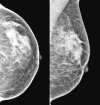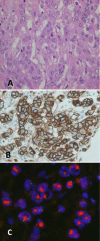Human epidermal growth factor receptor 2-positive microinvasive breast carcinoma with a highly aggressive course: a case report
- PMID: 24884941
- PMCID: PMC4046443
- DOI: 10.1186/1756-0500-7-325
Human epidermal growth factor receptor 2-positive microinvasive breast carcinoma with a highly aggressive course: a case report
Abstract
Background: Microinvasive ductal carcinoma in situ of the breast is a rare entity defined as ductal carcinoma in situ with invasive foci measuring no more than 1 mm. In general, the outcome is excellent, similar to ductal carcinoma in situ. We report a patient with breast ductal carcinoma in situ with microinvasion who died eight months after diagnosis due to progression of the disease - liver metastases. This is the first report in the literature of such an aggressive course.
Case presentation: A 47-year-old Caucasian woman presented with mammographic-detected suspicious microcalcinations in an area of 8.6 x 6 cm. A radical mastectomy with a sentinel lymph node biopsy and immediate breast reconstruction with implant was performed. A histopathological report showed a massive high grade ductal carcinoma in situ, of the solid and comedo type. In one quadrant, some foci of microinvasions of less than 1 mm were present. Tumour margins were free. Isolated tumour cells were found in the sentinel lymph node. Hormone receptors were negative and human epidermal growth factor receptor-2 status was not performed. The patient received no adjuvant systemic therapy. Eight months after the surgery, she died from hepatic failure without known breast cancer progression before. An autopsy revealed diffuse liver metastases with human epidermal growth factor receptor 2-positive, hormone receptor negative breast cancer. Dissemination to other organs was not proven.
Conclusion: Our patient is a rare case of ductal carcinoma in situ with microinvasion that developed distant metastases very early. In case of multiple foci of microinvasion, besides radical local treatment we suggest considering adjuvant systemic treatment based on biological characteristics since tumour size alone does not predict the prognosis well.
Figures


Similar articles
-
[Breast ductal carcinoma in situ with microinvasion: pathological review and clinical implications].Cancer Radiother. 2014 Mar;18(2):107-10. doi: 10.1016/j.canrad.2013.12.007. Epub 2014 Mar 14. Cancer Radiother. 2014. PMID: 24637020 French.
-
Microinvasive ductal carcinoma (T1mic) of the breast. The clinicopathological profile and immunohistochemical features of 28 cases.Pathol Int. 2003 Jul;53(7):422-8. doi: 10.1046/j.1440-1827.2003.01498.x. Pathol Int. 2003. PMID: 12828606
-
The hormone receptor, human epidermal growth factor receptor 2, and molecular subtype status of individual tumor foci in multifocal/multicentric invasive ductal carcinoma of breast.Hum Pathol. 2012 Jan;43(1):48-55. doi: 10.1016/j.humpath.2010.08.026. Epub 2011 Jul 5. Hum Pathol. 2012. PMID: 21733550
-
Metastatic "Ductal Carcinoma In Situ-Like" Lobular Carcinoma in a Lymph Node: A Case Report and Review of the Literature.Int J Surg Pathol. 2020 Jun;28(4):436-439. doi: 10.1177/1066896919888744. Epub 2019 Dec 1. Int J Surg Pathol. 2020. PMID: 31789065 Review.
-
Maximizing the Clinical Benefit of Anthracyclines in Addition to Taxanes in the Adjuvant Treatment of Early Breast Cancer.J Clin Oncol. 2017 Aug 10;35(23):2600-2603. doi: 10.1200/JCO.2017.72.5960. Epub 2017 Jun 29. J Clin Oncol. 2017. PMID: 28661760 Review.
Cited by
-
Incidence, characteristics, and management of recently diagnosed, microscopically invasive breast cancer by receptor status: Iowa SEER 2000 to 2013.Am J Surg. 2017 Aug;214(2):323-328. doi: 10.1016/j.amjsurg.2016.08.008. Epub 2016 Sep 2. Am J Surg. 2017. PMID: 27692792 Free PMC article.
-
Analysis of tumour-infiltrating lymphocytes reveals two new biologically different subgroups of breast ductal carcinoma in situ.BMC Cancer. 2018 Feb 3;18(1):129. doi: 10.1186/s12885-018-4013-6. BMC Cancer. 2018. PMID: 29394917 Free PMC article.
References
-
- American Joint Committee on Cancer. Breast. In: Edge SB, Byrd DR, Compton C, Fritz A, Greene FL, Trotti A, editor. AJCC Cancer Staging Manual. Part VIII. 7. New York: Springer; 2010. pp. 417–460.
-
- NCCN Guidelines: Invasive Breast Cancer. Version 2.2014. [ http://www.nccn.org/professionals/physician_gls/pdf/breast.pdf]
Publication types
MeSH terms
Substances
LinkOut - more resources
Full Text Sources
Other Literature Sources
Medical
Research Materials
Miscellaneous

